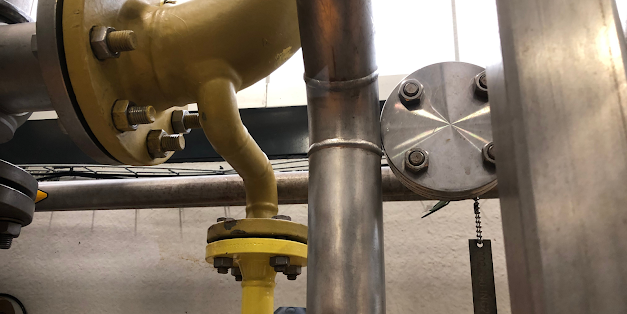
It is common sense that safety is an absolute priority in an industrial plant. Looking back at when safety procedures were still in its infancy, there are cases where things went wrong, often with dire consequences.
Fortunately, today the necessary precautions and measures are issued to ensure that mistakes from the past will never happen again. To safeguard your installation in the long term against all types of corrosion (pitting corrosion, crevice corrosion, stress-corrosion cracking,…), it is commendable to opt for a corrosion study.
The Seveso incident
In Seveso (Lombardy, Italy) on the 10th of July 1976 around 12.37 in the afternoon, an accident occurred due to a broken valve. This caused the release of a chemical cloud with the highest known exposure of TCDD (2,3,7,8-Tetrachlorodibenzo-p-dioxin, which became known as a contaminant in Agent Orange, a herbicide used in the Vietnam War).
As a result, within a week there were already cases of severe dioxin poisoning. Plant life wilted and thousands of animals died or had to be put down due to contamination.
The Seveso directive and SIT/017
Due to this particular type of corrosion incident, the European community reacted by imposing much stricter industrial safety regulations in 1982, called the Seveso Directive. Companies that handle, manufacture, use or store dangerous substances are called Seveso Establishments (i.e. refineries, oil depots, explosive depots, (petro)chemical sites).
In Belgium, these plants are repeatedly audited by the appropriate regional and federal inspection services to ensure the safety of the plant. During this inspection the Seveso establishments have to provide a clear answer to certain inspection and safety qualifications which are summarized in the SIT/017 form. That way, dangerous types of corrosion like pitting corrosion or crevice corrosion can be avoided.
Our answer to SIT/017
Avoiding different types of corrosion with a corrosion study
To meet the requirements of the SIT/017 form, we offer the solution of a failure mechanism study, which is also referred to as corrosion study.
A corrosion study identifies the possible degradation mechanisms per combination of material – medium – process conditions. In addition, a material degradation rate or susceptibility is determined. This allows a residual life of the installation to be estimated.
Corrosion studies are of great importance because:
- You will gain insight and awareness concerning the degradation mechanisms of your plant. Awareness is the first step into warranting the integrity of your installation.
- It offers a structured and substantiated answer to governmental requirements.
- A corrosion study is the key element of a RBI strategy. It allows you to optimize your inspection efforts when it comes to efficiency and budget.
TÜV AUSTRIA Belgium, formerly METALogic, uses its own approach to perform a corrosion study in a qualitative and structured way. This approach of the corrosion study (also followed by RBI) has been translated into our own designed software package CorLife.
Our secret ingredient to the recipe for a well-established solution to your inspection and safety strategy is our team of experts and a powerful software. This way, types of corrosion like pitting corrosion or crevice corrosion can be traced and resolved.
TÜV Austria Belgium’s solution in practice
A corrosion study is a team effort, bringing together the experience and knowledge of corrosion experts with inspection, process and maintenance personnel through team sessions. Our experts facilitate this process.
We’ll illustrate this with an example of implementation of a corrosion study process for a major pharmaceutical site.
TÜV AUSTRIA Belgium, formerly METALogic, was asked to perform a corrosion study on the piping of the production facility of one of the plants of the pharmaceutical company. The study encompassed the whole plant with approximately 15000 pipes. These studies are performed based on the customer requirements using our software tool that was developed in-house. Using a dedicated software, a study on a large plant with a high number of assets can be performed in a systematic way and the results can be accessed by the customer through a knowledge database.
The TÜV AUSTRIA Belgium, formerly METALogic, corrosion study served as a basis for the implementation of an inspection plan at the plant. In addition to the corrosion study, our project engineers assist on-site with the data collection and implementation of the inspection plan. In a current project that started in 2020, the study will be expanded with a similar analysis of the equipment.
This project did not only result in our client being compliant with the requirements of the SIT/017, but also to have the most urgent points of inspection highlighted so further action can be planned accordingly. This facilitates an efficient and cost-effective use of resources and budgetary means.

Risk-Based Inspection
The corrosion study is the ideal start of a RBI strategy.
In a Risk-Based Inspection strategy, inspection resources are deployed where they are most required. In other words, the inspection interval of a pipeline (or equipment part) is determined by the risk of failure. The risk of failure is the result of the probability of failure and the consequence of failure.
The outcome of the RBI study is an inspection plan which provides the following information for each pipeline or equipment part:
- a due date for inspection;
- the possible failure mechanisms;
- appropriate inspection techniques with which the degradation mechanisms can be inspected;
- Inspection histories, easily retrieved through the right software.






